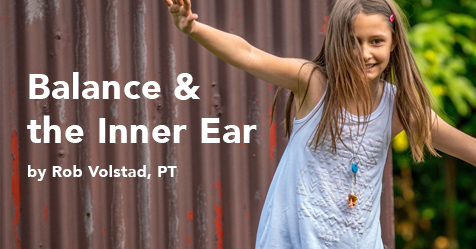Balance and the Inner Ear
Feb 17By Rob Volstad, PT – Raleigh, North Carolina Center
Good balance is something we often take for granted. Whether we are walking across a perfectly level floor or taking a hike in the woods, we rarely have to think about how we are keeping ourselves from falling over, and we can usually do it pretty easily.
Our balance actually is maintained by a highly sophisticated network of motor and sensory systems working in coordination and constant communication with each other.
Organizing this information is the human brain. It receives information from three primary sensory systems:
- First, our brain uses inputs from the eyes to tell us where we are in relation to our surroundings.
- Second, our brain senses what our feet, legs and lower body joints are feeling — what’s known as the somatosensory system — and uses that information to help make adjustments in our balance.
- Third, our brain uses inputs from the inner ear when it cannot rely on visual or somatosensory help.
The Role of the Inner Ear
The inner ear, also known as the vestibular system, acts as an internal gyroscope. We each have two systems that work together, one for the right ear and one for the left ear.
Within the inner ear are two primary networks for helping to maintain balance. The first system is known as the semi-circular canals. These are three fluid-filled hoops that help the brain sense angular motion of the head and body. There are six canals in total, insuring that every possible angle of motion is covered.
The second system is the otoliths. Within the otoliths lie little bony fragments called otoconia, also known as ear crystals or ear rocks. These crystals sit on top of nerves and help the brain sense linear motion of the head and body. For instance, when riding in an elevator, we can sense that the elevator is moving up or down even though our eyes tell us that nothing is happening. This is because of the sensitivity of the crystals shifting on the nerves.
As the brain receives and processes this information, it plans how to keep the body upright. Signals are sent down the spinal cord and out to the muscles of the trunk and legs, telling them how to adjust in order to maintain balance.
Likewise, the inner ear has a direct connection to the eyes. For every head movement, the vestibular system causes an equal and opposite adjustment of the eyes to keep the horizon on the level, thereby maintaining balance.
When the vestibular system is not functioning correctly, eye and head movements get out of synch, leading to dizziness, vertigo or imbalance.
Occasionally, the otolith crystals can become dislodged and find their ways into the semi-circular canals, where they roll around with every angular movement of the head, leading to brief bouts of vertigo usually lasting less than a minute. This is what is known as Benign Paroxysmal Positional Vertigo, and it easily can be treated with repositioning maneuvers that return the crystals to the otoliths.
Conclusion
The complexity of the balance system creates challenges in diagnosing and treating the underlying cause of imbalance. But doctors and physical therapists are becoming more skilled at successfully treating balance disorders.
While dizziness and imbalance become more common as we get older, they are never normal. There is always an underlying cause, such as an inner ear dysfunction, and there is almost always something we can do to help fix it.

